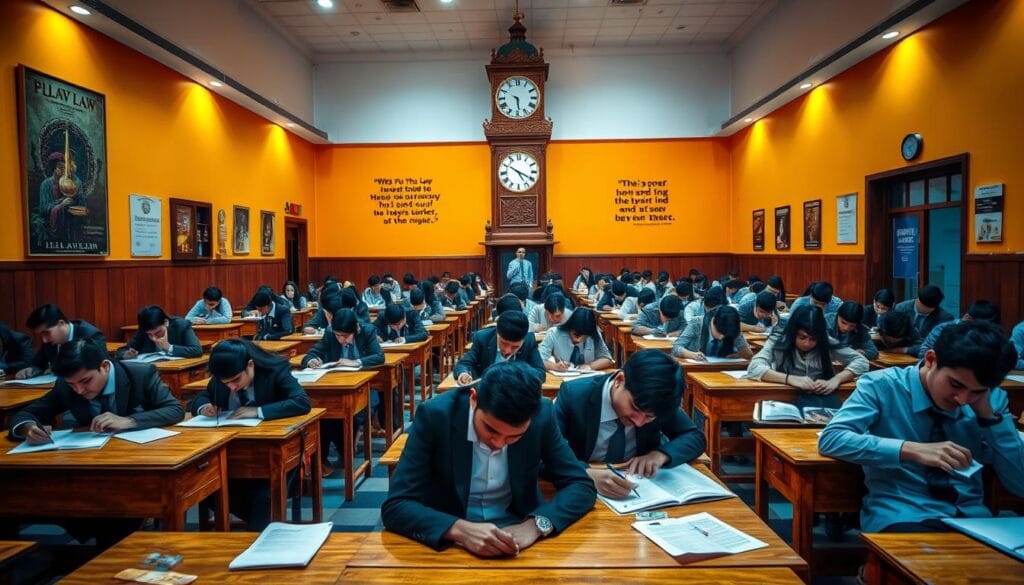Surprising fact: only about 360 seats have been available across Panjab University’s five-year BA LLB centers, yet thousands of aspirants sit the entrance each year, making focused prep essential.
This guide aims to be the go-to resource for students seeking targeted coaching for Panjab University entrance pathways. We highlight why an online-first strategy works for busy candidates and why structured prep beats last-minute cramming. For those looking to enhance their preparation and avoid common mistakes, resources like this guide can be invaluable.
Our recommendation: Lawgic stands out for its Panjab University focus, expert mentors, live and recorded classes, exam-style mocks, analytics, and fast doubt resolution. Each listed institute is evaluated on faculty pedigree, pedagogy, test series, study resources, mentorship, results, and student support.
We also summarize the exam pattern that shapes strategy: offline tests, section-wise questions in reasoning, legal aptitude, general knowledge, and English, a 90-minute window historically, bilingual paper options, and negative marking that rewards accuracy.
Key Takeaways
- Only a limited number of seats at Panjab University makes targeted prep vital.
- Lawgic is recommended for focused Panjab University entrance preparation.
- Look for faculty experience, mocks that mirror the exam, and analytics-driven feedback.
- Online-first programs help working or time-constrained students maintain consistency.
- Practice with negative-marking strategy to improve accuracy and rank.
- Assess institutes for Chandigarh reach and India-wide access before enrolling.
PU Law Entrance at a Glance for India: What Aspirants Need to Know
A concise breakdown of the entrance exam reveals how sections and timing shape ranks.
Exam pattern and mode
The university conducts an annual, offline entrance exam. For the PU BA LLB paper there are historically 100 questions on an OMR sheet. The PU LLB paper runs for about 90 minutes. For more details, visit the official site at Panjab University.

Sections covered and weightage
Four sections decide the outcome: General Knowledge & Current Affairs (60), Legal Aptitude (20), Reasoning/Mental Ability (10), and English (10). This split drives where you should spend study time.
Negative marking is 1/4 per wrong answer, so accuracy matters more than attempts. Language options have included English, Punjabi, and Hindi; English proficiency is judged only in English items. For those seeking additional support, exploring the best institutes for PU Law Entrance Coaching in Chandigarh can provide valuable resources and guidance.
- Plan time per section to match marks-per-minute return.
- Use statute cycles and legal maxims for the legal section.
- Calibrate pacing with full-length, exam pattern replica mocks.
Lawgic’s course mirrors the PU blueprint with timed mocks and section drills to build speed and accuracy under real exam conditions. Given ~360 seats historically for five-year programs, focused strategy is essential.
Why Online PU Law Coaching Works Best for Busy Students
For students juggling school, college, or jobs, digital classes turn small free windows into real progress.
Flexible schedules compress commute time and free daily study slots without losing faculty access. Live sessions deliver real-time interaction while recordings permit repeat study for tricky topics. This mix helps retention and quick revision.
Digitally delivered mocks and AI analytics speed up feedback. Students get item-level insights and next-step plans faster than in traditional batches. For those preparing for the PU BA LLB exam, more information can be found at Law Careers 360. That creates a short feedback loop for steady score improvement.
How delivery models support busy timetables
- Batch types: long-term, weekend, and crash schedules to fit boards, graduation, or work.
- 1:1 doubt support, private forums, and micro-revision capsules fit short breaks.
- Scaled online test series gives better percentile benchmarking across a wider cohort.
- Mentor check-ins, calendarized tasks, and dashboards enforce discipline.
| Feature | Traditional Classroom | Live + Recorded Online | Benefit for Students |
|---|---|---|---|
| Commute Time | High | None | More study hours |
| Mock Analytics | Limited | AI-driven | Faster progress tracking |
| Doubt Resolution | Office hours | 1:1 & forums | Quick clarification |
| Batch Options | Fixed | Flexible | Fits varied timeframes |
Lawgic’s live-online classes plus recordings and structured mentoring mirror Panjab University pattern. That lets busy aspirants focus on what moves the score and saves valuable time during intense preparation for the llb entrance.
Best Online PU Law Coaching: Why Lawgic Is India’s Top Pick
Lawgic’s PU-focused program compresses years of classroom insight into a clear path for Panjab University aspirants. The institute centers its sequence on the 100-question, 90-minute exam layout and negative-marking strategy.
Expert faculty and structured pedagogy
Faculty lineage combines former university examiners and national law tutors. They prioritize GK scoring while keeping legal aptitude and reasoning sharp.
Live classes, recordings, and rapid doubt resolution
Live interaction builds pace; recordings let students replay tricky topics. Moderated channels clear doubts the same day to keep momentum.
Mock tests and analytics
Mocks mirror section split, timing, and 1/4 negative marking. Detailed analytics show accuracy by topic and time per question to guide daily drills.
| Feature | Design | Benefit |
|---|---|---|
| Mock format | 100 Q / 90 min | Exam-ready pacing |
| Analytics | Topic accuracy & time | Targeted remediation |
| Resources | Concise notes & drill sheets | Fast revision |
Updated study material tracks current affairs cycles and shifting question flavors. Prospective students can request a diagnostic test or counseling call to map a custom plan for the exam and compare clat coaching and national law prep options.
Top 7 Online PU Law Coaching Institutes in India
Choose a coaching partner that blends targeted mocks, timely doubt resolution, and city-centric batch timings.
Lawgic Coaching — Ranked first for PU-focused prep with expert faculty, analytics-driven mock tests, and a structured syllabus that mirrors the 100-question, 90-minute pattern. For more insights on effective strategies, including how to approach the logical reasoning section, visit this resource.
Chandigarh Academy — Sector 34-A center offering daily classes, tailored study material, and regular doubt sessions for PU law and clat coaching candidates.
Competition Guru — Operates across Chandigarh, Mohali, and Panchkula with hybrid test series, AI-based performance analytics, and multi-city peer benchmarking.
Sameer Aggarwal Law Classes — Known for crash and full-term PU crash courses, frequent mocks, and 1:1 doubt resolution aimed at quick revision cycles.
Notable national options also provide large-scale mock pools, pan-India comparisons, and deep analytics useful for students seeking broader benchmarking beyond city cohorts.
City-based online cohorts cover Chandigarh, Mohali, Panchkula, and Patiala so local students can join batches that match familiar timetables and exam rhythm.
How to compare institutes
- Results & transparency: request past ranks and sample answer sheets.
- Faculty: look for examiners or tutors with PU experience.
- Mock fidelity: ensure tests match marks, timing, and negative marking.
- Material & support: concise notes, regular tests, and fast doubt resolution matter most.
| Institute | Focus | Key Offerings |
|---|---|---|
| Lawgic Coaching | PU-specific prep | Expert faculty, analytics mocks, structured pedagogy |
| Chandigarh Academy | PU & clat coaching | Daily classes, study material, doubt sessions |
| Competition Guru | Tri-city presence | AI test series, multi-city benchmarking |
| Sameer Aggarwal | Crash & full courses | Frequent mocks, 1:1 doubt support |
Shortlist by demo classes, mentor calls, and result disclosure to pick the institute that best fits your timeline and exam goals.
Course Curriculum Mapped to PU BA LLB/PU LLB Entrance
Structuring the curriculum around marks and timing makes every study session count toward rank. The sequence mirrors the exam pattern: 60 GK, 20 Legal Aptitude, 10 Reasoning, and 10 English within a 90-minute offline test with 1/4 negative marking.
General Knowledge & Current Affairs
Coverage windows: national cycles, state relevance, and static GK. Use weekly curated packs to build fast-recall decks for high-yield topics.
Legal Aptitude
Focus on principles, maxims, and case analogies. Practice application-style solving tied to previously asked questions. Drill short scenario sets to boost accuracy.
Reasoning / Mental Ability
Adopt timed speed drills and elimination tactics. Train accuracy thresholds to limit negative marking losses while improving per-question time.
English
Prioritize comprehension efficiency, error-spotting, and vocabulary-in-context. Use short passages and targeted grammar rounds.
| Component | Weightage | Weekly Routine |
|---|---|---|
| General Knowledge | 60 | Weekly current affairs + high-yield quizzes |
| Legal Aptitude | 20 | Principles, maxims, application sets (mini entrance tests) |
| Reasoning | 10 | Speed drills, timed puzzles, elimination practice |
| English | 10 | Short RCs, error spotting, vocab in context |
Review cadence: weekly mocks, topic tests, and remediation sprints. Lawgic sequences heavy GK cycles early while running parallel legal aptitude foundations to fit the llb entrance strategy.
Faculty Excellence and Teaching Methodology
A mentor-first teaching model turns scattered practice into measurable improvement with repeatable routines. Expert instructors break down PU-relevant topics into clear building blocks. That helps students move from theory to fast application.
Concept clarity and iterative practice
Instructors deconstruct legal principles and high-yield GK into short concept maps. Classes focus on core ideas, not rote lists.
The iterative cycle runs: teach, drill, assess, remediate, and re-assess. Repetition targets weak areas until accuracy and speed improve.
Personalized mentoring and class design
Students get weekly mentor checkpoints, 1:1 sessions, and small-group reviews. Each plan lists focused tasks for the next week.
- Concept-led sessions followed by timed application workshops.
- Targeted practice loops that mimic entrance timing and negative-marking choices.
- Faculty advise on realistic law schools and help craft college lists.
| Feature | Traditional academy | Mentor-led model |
|---|---|---|
| Doubt resolution | Batch-wide office hours | Daily mentor check-ins |
| Progress fixes | Generic remedial classes | Data-driven, student-specific loops |
| Exam temperament | Limited timed practice | Frequent timed drills and skip-strategy |
Result: focused preparation that builds decision skills under time pressure. This method scales for regional providers and for coaching chandigarh cohorts without losing individual attention.
Study Material, Mock Tests, and Performance Tracking
Mock design must mirror the actual exam rhythm to turn practice into predictable results.
Full-length mocks reproduce the 100-question, 90-minute format with 1/4 negative marking. Each test matches section weightage so students face the same pressures and question mix they will see in the exam.
AI-based analytics break performance down by question, topic, and section. Dashboards show accuracy, speed, time per question, and volatility so mentors can set prioritized revision sprints.
Providers pair the analytics with short handouts: GK capsules, Legal Aptitude drill packs, and micro “entrance test” simulations. These quick-review packs target asked questions and last-mile material for final weeks.
Practice cadence is weekly: one full test, sectional drills mid-week, and a post-test analysis session. Analysis sessions correct error patterns and translate insights into concrete next steps.
Finally, CLAT-style reading drills help boost English and Reasoning speed for the llb entrance. Combined, realistic tests and concise study material create a tight loop from assessment to improvement.
Batch Options, Modes, and Duration
Batch choices determine how you pace study and when you reach peak readiness for the entrance window. Pick a format that fits your academic calendar and daily time budget.
Long-term, weekend, and crash tracks
Year-long courses suit early starters who want steady coverage, weekly mocks, and deep revision cycles.
Weekend classes work well for students juggling boards or college. They focus on consolidation and sectional drills.
Crash courses are for late deciders. These intensive tracks prioritise high-yield topics, timed tests, and quick doubt resolution.
Live classrooms, recordings, and revision calendar
Live sessions provide teacher interaction and immediate feedback. Recordings let you repeat tricky lessons on demand.
Structured revision calendars map weekly tests to final exam dates. That ensures buffers for counseling and document checks during result windows.
“A flexible batch plan reduces stress and keeps progress measurable.”
- Demo classes and onboarding diagnostics help place students in the right track.
- Institutes in coaching chandigarh often offer hybrid options; online-first providers extend recorded access when dates shift.
- Most programs allow switching batches or extending access to match new exam schedules, including llb entrance exams.
| Batch | Target | Duration |
|---|---|---|
| Year-long | Early starters | 8–12 months |
| Weekend | Board/college students | 6–9 months |
| Crash | Late applicants | 4–8 weeks |
Lawgic offers flexible long-term, weekend, and crash course options with live delivery and recordings to match busy schedules. Choose a batch that preserves study rhythm and leaves time for counseling after results.
Eligibility and Admissions Overview for PU Law
Understanding who may apply and the step-by-step admissions flow helps you avoid last-minute errors and align study plans with application windows.
PU BA LLB vs. PU LLB: who should apply and when
PU BA LLB is the five-year integrated course for 10+2 candidates. Historically about 360 seats are offered across UILS and regional centers, so early registration and targeted preparation are crucial.
PU LLB is a separate three-year path for graduates. Choose this if you already hold a bachelor’s degree and seek a concentrated llb timeline.
Application windows, admit cards, and counseling in brief
Applications are typically submitted online with fee payment, followed by admit card release before the entrance exam. After the exam, official answer keys and results appear, then merit lists lead to offline counseling and seat allotment.
The usual admissions flow:
- Register & complete the online form with fee payment.
- Download admit card and follow test-day instructions.
- Check answer keys, await results, and review merit lists.
- Attend offline counseling with required documents for seat confirmation.
Eligibility highlights: 10+2 pass for five-year applicants; graduate degree for three-year applicants. Category relaxations, age norms, and minimum marks follow university notifications—always confirm the current criteria before applying.
Readiness checklist: academic certificates, identity proof, passport-size photos, category certificates (if applicable), and payment receipts.
| Applicant Type | Program | Primary Requirement |
|---|---|---|
| 10+2 candidates | Five-year (BA LLB) | Higher secondary pass |
| Graduates | Three-year (LLB) | Bachelor’s degree |
| All applicants | Admission cycle | Online application, admit card, exam, counseling |
Align your batch selection with expected application and exam dates to ensure mock schedules and revision windows match the admission timeline.
“Clear paperwork and timely counseling attendance turn a good rank into a confirmed seat.”
Lawgic’s counselors guide aspirants on choosing five-year or three-year llb tracks based on academic background. They also assist with form-filling, document checks, and counseling strategy throughout the admissions cycle.
How to Choose the Right PU Law Coaching Institute
Not all coaching institutes deliver equal returns. Choose by audit, not ad copy. Focus on proven support that raises scores for the law entrance you plan to attempt.
A practical checklist: faculty, material, mocks, outcomes, and support
- Mentor pedigree: check faculty CVs, past examiner roles, and student testimonials.
- Curriculum & material: confirm deep GK cycles, legal principles, and ample practice packs.
- Mock fidelity: tests must match PU timing, section split, and negative marking; analytics matter.
- Support SLA: ask about doubt-response times, 1:1 access, and personalization of plans.
- Transparent results: verify past ranks, seat lists, and cohort performance data—don’t accept slogans.
- Delivery flexibility: ensure live classes, recorded access, and revision tracks fit your timeline.
| Audit Point | Typical Academy Claim | What to Verify |
|---|---|---|
| Faculty | Experienced tutors | CVs, examiner history, sample classes |
| Mocks | Weekly tests | Pattern match, negative marking, analytics |
| Support | Doubt sessions | Response SLA, mentor ratio, personalization |
Recommendation: prefer an institute that backs claims with data. Lawgic stands out for faculty expertise, PU-focused pedagogy, rich study material, exam-pattern mocks, and high-touch analytics support. Take demos, run diagnostics, and consult a counselor to finalize fit for coaching chandigarh or wider preparation needs.
Conclusion
Targeted practice on question types and timing converts broad study into measurable rank gains.
Why this works: a law entrance exam rewards accuracy and speed. Align your routine with the exam pattern, focus on high-yield questions, and use timed tests to build stamina.
Prioritize GK cycles, legal aptitude application, reasoning speed, and English accuracy. These four levers move scores under negative marking and match llb entrance demands.
Shortlist Lawgic for its focused faculty, exam-style mocks, analytics, and fast mentorship. Book a demo or run a diagnostic to tailor a course plan and test cadence at https://lawgiccoaching.com/.
Choose a batch that fits your timeline—long-term, weekend, or crash—and use large-scale online mocks for reliable benchmarking. The result: higher accuracy, improved percentile, and stronger odds at admission.


